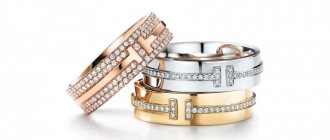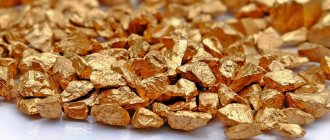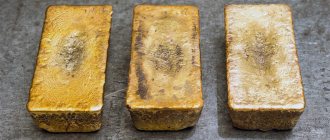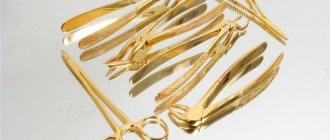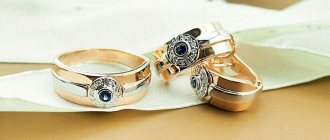Post updated: May 27, 2020
Since time immemorial, people have encountered the beautiful yellow metal. They worshiped him, idolized him, because of him they went on campaigns and started wars. Gold is ideal for processing and investment. White gold contains expensive platinum metals, giving it a high value.
Types of gold
In its pure form, this metal has a yellow color, but with the help of impurities, gold can be given different shades. Pure gold is not used in jewelry, only alloys. Gold purity means the quantitative content of precious metals in the alloy.
Pure gold.
You can only find gold in its pure form in the laboratory where it is obtained. In nature, metal is found with impurities of silver or copper. 999 gold is considered the purest. Sometimes it is called bank or red.
White gold.
It is an alloy of gold and another white metal that can give gold a white color. What the alloy called “white gold” is made of can be understood by its color. Ligatures for white gold can be: manganese, nickel, palladium. This alloy began to gain popularity at the beginning of the twentieth century. They began to use it instead of expensive and refractory platinum.
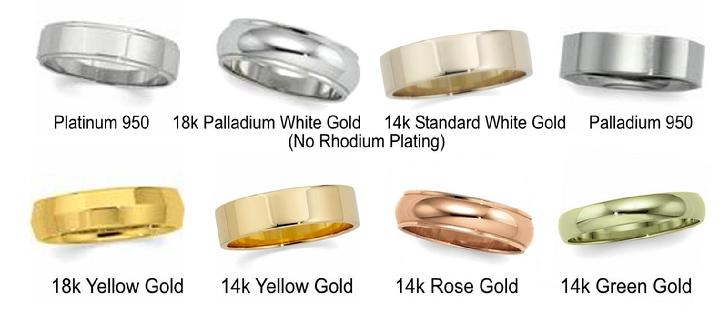
Shades of gold range from white to green.
Red gold.
It is an alloy of gold and copper. The color determines the amount of the latter. Red gold contains almost the same ratio of two metals. Red gold began to be actively used at the beginning of the 19th century. In European countries, this type of precious metal is treated quite dismissively. Despite this, due to its composition it has greater hardness than yellow, due to which it wears off less. Because of these properties, red gold can be safely used to make delicate openwork jewelry.
Yellow gold.
This is the classic and most common type. Gained popularity several centuries ago. To give strength to pure gold, silver and copper are added to the alloy. They help improve the strength characteristics of the metal. The most popular alloys are 585 and 750 yellow gold.
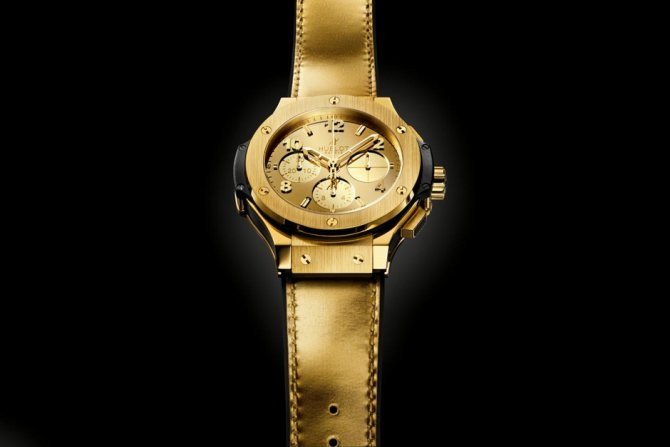
Yellow gold is most popular in Russia.
Green gold.
This alloy contains silver. The greater the proportion of silver in the alloy, the lighter it is. Also, green gold alloy is obtained by combining gold and rubidium. Green gold is very beautiful, but has low strength.
Black gold.
In order for the alloy to have a black color, the surface of the product is coated with black rhodium or ruthenium, or an alloy is made of gold, cobalt and chromium, the surface of which is oxidized artificially.
There are fierce debates about which alloy is more noble: white or yellow? Each type of gold has unique characteristics and unique value. The use of both is subject to fashion: in different centuries it turned to different colors and shades.
Yellow metal goes well with dark skin, it is more noticeable and has a characteristic shine, however, white metal goes much better with diamonds, which is why (if we omit the physical characteristics of the alloy) it is mainly used to make settings for precious stones. However, we should not forget that the value and nobleness of a metal is determined by its breakdown. Therefore, yellow and white gold of the same purity will have the same value.
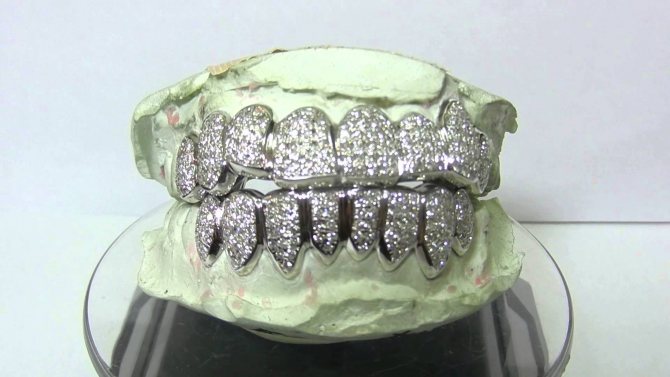
White gold looks very attractive with diamonds.
Alloys contain not only gold; much depends on the content of impurities. Nickel is added to white gold as an alloy, which causes an allergic reaction more often than other precious metals. Because of this property of the white gold ligature, its use was limited in Europe. They tried to replace nickel with palladium, however, many of the characteristics of nickel remain irreplaceable. Thus, it has great hardness and is highly polished. This allows the use of alloys containing nickel to create original jewelry with complex designs. It is simply not possible to create such straight and clear shapes from soft metal.
White gold is considered noble if the alloy contains metals such as platinum or palladium.
Platinum is one of the best options for “whitening” yellow gold. It is this that gives the precious alloy strength and a beautiful shade.
The popularity of white gold largely depends on fashion, but there are things that do not lend themselves to its trends. Jewelers who work with diamonds prefer white gold to yellow gold, as the resulting jewelry is more refined and pure. Its color highlights the advantages of a diamond, while yellow gold can hide some flaws.
Jewelry designers generally prefer white gold, primarily because it can easily be combined with metals of other colors. Jewelry made from metals of different colors allows you to create new, unexpected solutions, when single-color jewelry provides much less room for imagination.
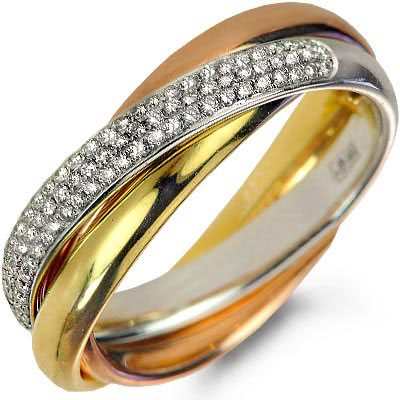
Jewelry masterpieces are made from gold of various shades.
White gold is almost universal. Jewelry made from this alloy is surprisingly easy to combine with any color of hair, eyes and even skin. Traditional yellow gold is more difficult to wear every day; jewelry made from it is brighter and more catchy. White gold does not stand out, it is modest and not vulgar. Although, this is just a matter of taste.
Why isn't pure gold used in the jewelry industry?
The physical properties of pure gold are amazing: it is very easy to forge, is an excellent conductor of electricity, and helps focus mirrors that operate in the far infrared range.
In industry, there are many uses for pure, pure gold, however, this precious metal also has its drawbacks:
- It is very easy to forge. For jewelry, this is the biggest drawback;
- It wears out and bends easily;
- Pure gold jewelry quickly gets scratched and loses its shine and beauty.
Tips for care, cleaning and storage
I have written a short reminder on caring for white gold jewelry - use it.
- Every thing has its place! Jewelry is not stored in bulk; it is carefully laid out in compartments so as not to damage the stones or scratch the surface.
- Precious metal is covered with craters under the influence of acids or hot alkali. Therefore, wash the jewelry with soapy water without aggressive chemicals. Rinse with warm water and polish with a flannel.
- It is acceptable to use dry tooth powder or gruel with water for cleaning.
How is white gold made?
Why is gold called “white”? The white tint of gold is given by metals such as palladium, platinum, and silver. White gold with the addition of platinum is one of the most expensive alloys. Jewelry made from such metal is sold only by large chains of jewelry stores, counting on people who are able to buy such jewelry.
An alloy of gold and nickel is more accessible. It has all the properties of noble white gold; such an alloy can be distinguished only by its slightly dull shine. In addition to external characteristics, the alloy with nickel also loses in relation to human health, but not always. It all depends on how the white gold alloy is made. The fact is that nickel can cause irritation or allergies. Because of this, in Europe, starting in January 2000, a decree was passed prohibiting the use of nickel in jewelry and coins if its content exceeds the permissible limit. But if the jewelry is covered with a protective layer, there is nothing to be afraid of.
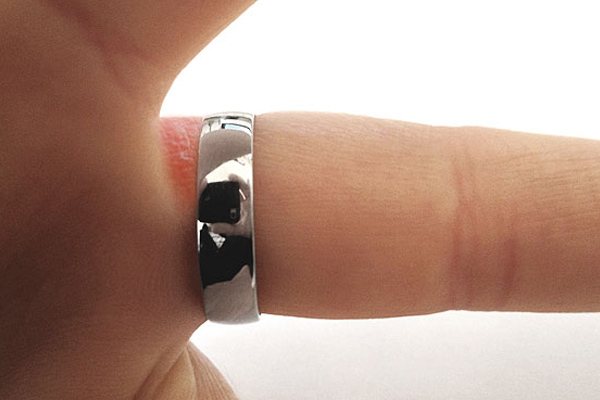
Nickel in white gold alloy can cause allergies.
If one tenth of platinum is added to pure gold, the alloy acquires a characteristic white tint and physical properties such as strength and chemical resistance.
If the jewelry uses a 585 alloy, then about half of it is gold, the rest is platinum and silver. Such a product will delight the owner with its impeccable whiteness and durability.
If palladium or nickel is added to gold, the metal will receive an almost imperceptible yellow tint.
How is “pure” white gold obtained? Not all white gold alloys have a characteristic color; in order for the product to amaze its owner with the purity of the shade, it is coated with rhodium. This metal belongs to the platinum group and is more expensive than gold. Jewelry coated with it is more resistant to scratches, abrasion, and deformation. Rhodium coating allows the use of nickel in alloys without harm to health. Therefore, despite the fact that the jewelry is still an alloy of metals, its value is close to pure gold.
Historical reference
The opinion that white gold is a different metal did not arise out of nowhere. In the beginning, when platinum was not so well known and popular, it was actually called white gold. And they even replaced it with the real thing in jewelry and coins.
Platinum came to the Old World from America. The ancient civilizations of the Incas and Mayans have been processing the precious metal since time immemorial. Its refractoriness, inertness and high density were valued at the level of gold. However, these properties were not immediately noted. The metal was even disparagingly called “silver” (in Spanish, plata - silver) due to its color similarity to argentum.
The first deliveries of platinum were simply drowned in rivers and the ocean. The Spanish monarch issued a decree prohibiting its import into the territory of his country. Only 40 years later the new chemical substance was rehabilitated. The king's descendants began to counterfeit gold coins with his help. Platinum had a higher specific gravity than silver, and therefore the fact of falsification was not immediately discovered. The color of the new connection was revealed to the greedy rulers.
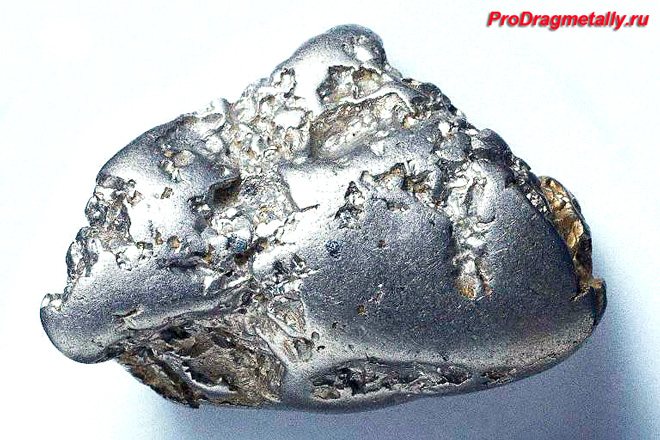
Even with 8–10% platinum alloy, the coins became white and resembled silver.
The second case in history when platinum was mistakenly called white gold happened during the development of the Ural mines. The new "Siberian metal", discovered in veins and impurities of gold ore, differed from previously known chemical elements. Having highly appreciated its properties, Russia began its production on an industrial scale. Within a couple of years, a method was invented to make platinum forgeable.
How to distinguish white gold from silver?
These two precious metals are very similar in appearance, but silver is much cheaper than white gold, in addition, silver is only a ligature for expensive white gold. How to recognize silver?
First of all, you should pay attention to the standard: gold jewelry uses 585 or 750 standard, silver 925. White gold has a brighter shine than silver. In addition, it is harder than silver.
What difficulties will the owner of white gold have to face?
The capricious alloy of white gold must be carefully monitored: periodically take the product to a jeweler in order to correct the rhodium layer, if any. White gold can become damaged during everyday wear if it comes into contact with harsh chemicals or if it comes into frequent contact with tap water, which may contain bleach.
Price
The price of white gold, or rather jewelry made from this jewelry alloy, is influenced by many factors. First of all, this is the standard of the metal - the higher the standard, the more expensive the jewelry.
Thus, a product made from an understated 300 or 385 standard, despite its white color, is essentially costume jewelry, so the low cost of the jewelry should certainly alert you. Especially if there is no mark on it. White 585-karat jewelry is always more affordable than 750-karat jewelry, since they contain less gold.
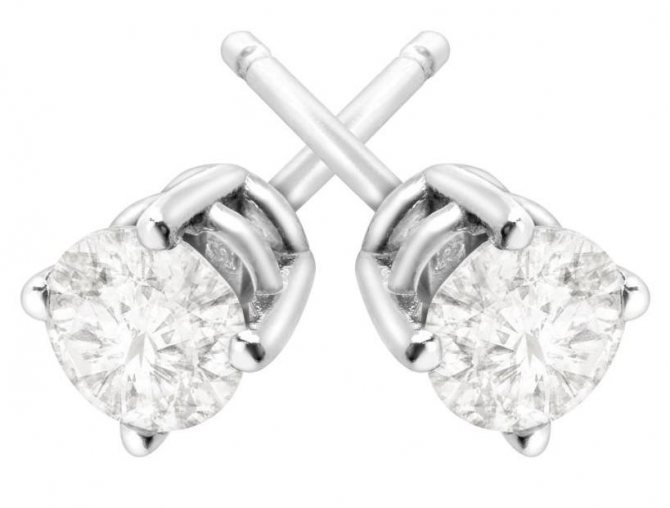
In addition to the sample, the cost of jewelry is also affected by the complexity of its manufacture and the presence of precious stones in the product.
Another factor influencing the cost of jewelry is its weight. The price of white gold, like any other, is set per gram and is regulated by an international exchange. The average cost of 1 g of white gold (585 samples) ranges from 2100 to 3500 rubles. Therefore, the heavier the jewelry, the more expensive it will cost.
